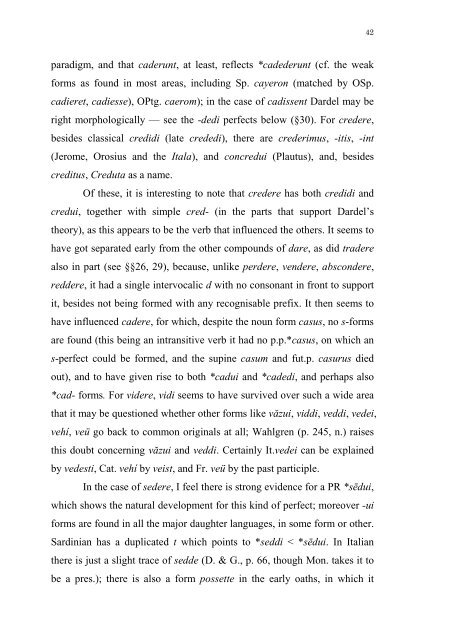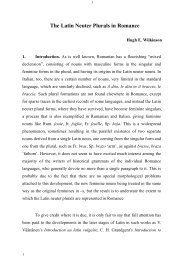THE STRONG PERFECTS IN THE ROMANCE ... - Page ON
THE STRONG PERFECTS IN THE ROMANCE ... - Page ON
THE STRONG PERFECTS IN THE ROMANCE ... - Page ON
Create successful ePaper yourself
Turn your PDF publications into a flip-book with our unique Google optimized e-Paper software.
paradigm, and that caderunt, at least, reflects *cadederunt (cf. the weak<br />
forms as found in most areas, including Sp. cayeron (matched by OSp.<br />
cadieret, cadiesse), OPtg. caerom); in the case of cadissent Dardel may be<br />
right morphologically — see the -dedi perfects below (§30). For credere,<br />
besides classical credidi (late crededi), there are crederimus, -itis, -int<br />
(Jerome, Orosius and the Itala), and concredui (Plautus), and, besides<br />
creditus, Creduta as a name.<br />
Of these, it is interesting to note that credere has both credidi and<br />
credui, together with simple cred- (in the parts that support Dardel’s<br />
theory), as this appears to be the verb that influenced the others. It seems to<br />
have got separated early from the other compounds of dare, as did tradere<br />
also in part (see §§26, 29), because, unlike perdere, vendere, abscondere,<br />
reddere, it had a single intervocalic d with no consonant in front to support<br />
it, besides not being formed with any recognisable prefix. It then seems to<br />
have influenced cadere, for which, despite the noun form casus, no s-forms<br />
are found (this being an intransitive verb it had no p.p.*casus, on which an<br />
s-perfect could be formed, and the supine casum and fut.p. casurus died<br />
out), and to have given rise to both *cadui and *cadedi, and perhaps also<br />
*cad- forms. For videre, vidi seems to have survived over such a wide area<br />
that it may be questioned whether other forms like văzui, viddi, veddi, vedei,<br />
vehí, veü go back to common originals at all; Wahlgren (p. 245, n.) raises<br />
this doubt concerning văzui and veddi. Certainly It.vedei can be explained<br />
by vedesti, Cat. vehí by veist, and Fr. veü by the past participle.<br />
In the case of sedere, I feel there is strong evidence for a PR *sēdui,<br />
which shows the natural development for this kind of perfect; moreover -ui<br />
forms are found in all the major daughter languages, in some form or other.<br />
Sardinian has a duplicated t which points to *seddi < *sēdui. In Italian<br />
there is just a slight trace of sedde (D. & G., p. 66, though Mon. takes it to<br />
be a pres.); there is also a form possette in the early oaths, in which it<br />
42









